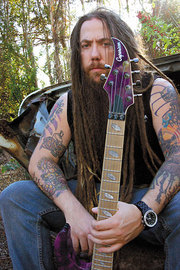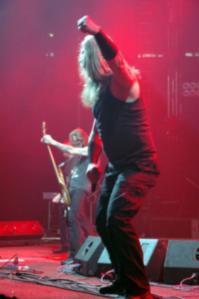Those who consider Europe civilized should’ve experienced this sweaty night of battle-metal from Sweden, Finland, Austria and Florida. Well, we already knew about Florida.

Tampa’s The Absence opened the hostilities. Second time I’ve seen ‘em, and they continued to dent foreheads with their distinctive Dixie metal, a riproaring combination of Iron Maiden twin guitars and high school cheerleading (with yards o’ hair). “Dead and Gone” swaggered at us dick foremost; “World Divides” thumped with a bull-snorting rhythm; “From Your Grave” managed to be both heavy and jaunty -- these crackers f*ckin’ TRUCKED, modern-style of course, with woofin’ vocals rather than sangin’. Drummer Justin Reynolds sounded like an entire halftime marching band using mostly his feet, reserving his arms to flick easy accents around the kit. There was a sweet moment when little bush-bearded throatman Jaime Stewart flung a paw around huge sasquatch guitarist Peter Joseph (pictured), the virtuosic twirling of whose knee-length dreads distinguished a quintet that’s second to none in that vital metal category. One suggestion: I think they can quit belaboring their thrash credentials by closing with Testament’s “Into the Pit”; The Absence have got their own thang. A satisfying 25 minutes.
Austria’s Belphegor exceeded my high expectations. I knew I’d hear rhythmic torrents graced with medievally gloomy buzz-picked guitar melodies. What I didn’t anticipate was that the band would remind me so much of Albert Ayler’s avant quartet circa 1965, with guitarist-rasper Helmuth playing the Albert role and broad-chested shirtless skinsman Torturer rattling around the snare and toms in abstract fashion like Sunny Murray. Adding to the Teutonic afro-jazz vibe, the sound boiled up ever bigger like the caldron of the gods on “Seyn Todt in Schwartz” (schwartz = black), evaporated in churchy interludes and condensed into cold anvil rhythms as a strobe outlined Helmuth’s hulking form and bassist Serpenth whanged out echoing bass noises like the clash of crude broadswords. It was beyond metal.
Though many a head banged to Belphegor, on this Viking-themed night more brutes thronged to chant along with Finnish folk-metalists Ensiferum. These manly musicmen wore skirts and -- with the unfortunate exception of the female keyboardist, whose instrument was shielded behind, uh, a shield -- went topless as they spieled out their heavier/louder version of Blackmore’s Night. While Ensiferum’s prancy Riverdance thrash carried a respectable level of technicality (one song was in, I’m gonna say, 11/8), the cornball costumery cloyed, and the audience hey-heying along to noble exhortations reminded me of all the stupid patriotic reasons people go to war rather than the good healthy reasons like wanting to kill those bastards who’re stealing your cattle. Maybe Ensiferum’s ancestors and mine belonged to feuding tribes. I instinctively hated them.

Sweden’s Amon Amarth were funnier when I saw them with Children of Bodom a couple years back, but better this time, when they got to stretch out in a full-length set and indulge in more lightning flashes and stage smoke. The mystery of the evening related to the ox-horn that hung from strapping bearded voxman Johan Hegg’s belt: Blowin’ horn or drinkin’ horn? Hegg (pictured above) maintained the suspense till he rewarded himself for his exertions by quaffing deeply from the vessel late in he set. Up to then and thereafter, Hegg manhandled the crowd, striding up and down in front of a lurid backdrop (a Thor figure menacing a dragon with a big hammer, the cover of the band’s new CD/DVD “Twilight of the Thunder God”) and bellowing stuff like “We shall die!,” which we all considered a grand notion. The fluidly melodic guitar leads of Olavi Mikkonen stood out from the headlong rumble -- while Amon Amarth made a big noise, they divided the musical space into big muttony chomps easily devourable by a large crowd. “Where Silent Gods Stand Guard” skillfully combined two key aspects of Presleyan showmanship: early railroad clack reminiscent of “Mystery Train” (but obviously heavier) and bawling Vegas bathos like “How Great Thou Art” (without the melody/harmony). The masses chanted apace, clapping hands above heads and howling in approval as Hegg avowed his deep desire to have a mound erected in his memory. The Sabbath-sludgy “Amon Amarth,” the urgent infantry-charge “Where Is Your God?,” the midtempo pounder “Gods of War Arise” and an encore that included the sing-along “With Oden on Our Side” served notice of a band that’s here to deliver both entertainment value and bloodlust service, which to this 90-percent-male L.A. battalion meant about the same thing. Youth demands a mission! One can only wish that rock sufficed.
